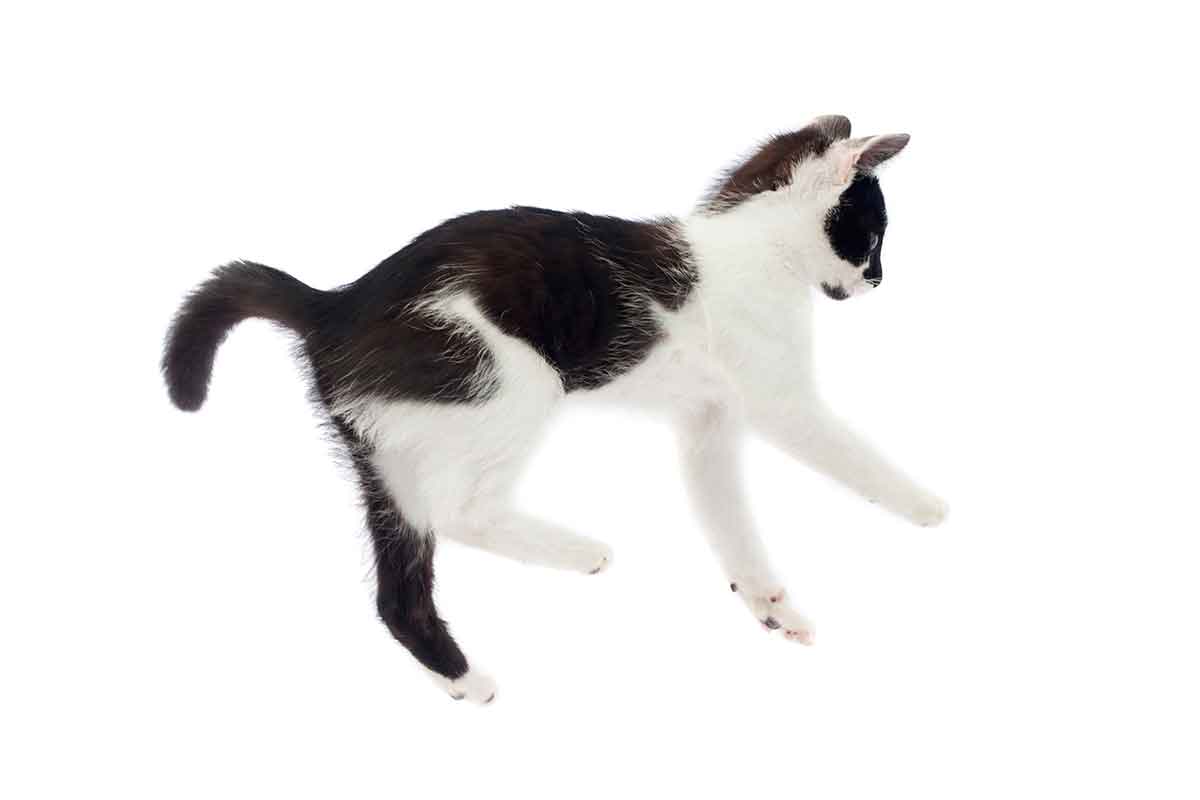Amazed by your cat’s acrobatic skills? Feline physics is the secret to dramatic leaps and landings.
Cats are equal parts mystery, myth, and masters of physics who have confounded scientists and owners for ages with seemingly impossible feats. A cat’s uncanny ability to land upright from a fall is a physics mystery that has perplexed researchers for centuries. This remarkable righting reflex is a natural gift custom-made for cats.
It’s So Easy, Kittens Do It
The innate righting reflex is an automatic response that corrects the body’s orientation when it isn’t in its normal, upright position, allowing cats to land on their feet when they fall or jump to the ground. Kittens begin to use the reflex at approximately 3 weeks of age and master it by the time they’re 7 weeks old.
The 30 exceptionally flexible vertebrae in the spine enable felines to stretch out, compress, arch the back, and rotate, bend, and twist the front half of the body independently from the back half. The small or sometimes nonexistent collarbone also contributes to back arching and helps the front legs absorb the shock of landing. These physical attributes get an assist from the vestibular apparatus, the fluid-filled cochlea in the inner ear, which provides a keen sense of balance. This apparatus is responsible for body orientation and equilibrium.
As a cat starts to fall and senses disorientation, the back bends, creating two separate axes of rotation. The head and front half of the body rotates first in one direction, and the front legs tuck in close to the face as the front part of the body twists toward the ground. Simultaneously, the back half separately rotates with the back legs outstretched, creating less rotation than the front half.
Then the switch-up occurs. With the front part of the body facing the ground, the front legs extend, reaching for the ground while the hind legs tuck in. The reverse actions slow rotation of the front half of the body and increases rotation of the back half. Just before landing the back legs reach out for the ground, which slows the rotation and allows the back part to catch up with the front half. The back arches to stabilize the body to prevent further rotation.
Touchdown!
During the free fall, the cat’s body relaxes and spreads out, resembling a feline parachute. The tail doesn’t play a role in the actual righting reflex. The tail may aid stability on landing, but tailless cats breeze through the maneuver.
Stick The Landing
Cats need enough time and space to achieve this grace in motion. The righting reflex can take less than a second and a cat needs at least two and a half feet to stick the landing. That doesn’t mean every cat nails every landing every time. Cats do sustain injuries from falls; it happens so often the cluster of injuries has a name: “high-rise syndrome.” Researchers discovered that cats who fall from seven stories or higher more often land on their feet than from falls of shorter heights but experience more severe injuries. The most common injuries include chest trauma, broken bones, and facial and dental injuries. Cats can also die from high falls.
To help protect your cat from injuries, kitty-proof your home by securing unstable furniture such as book cases. Close open windows or cover them with sturdy screens; most screens are made to keep bugs out–not cats in. Add a screened enclosure to your balcony if your cat has access to it.
What perplexed researchers for so long about the righting reflex is that cats don’t push off from a surface but rather use torque from the body. It’s a physics conundrum that’s perfectly feline. While researchers continue seeking answers to feline mysteries, cats know Mother Nature designs elegant efficiency.
One last thing: As fascinating as it is to see cats perform this feat, please don’t intentionally drop your cat to see if he will land on his feet. There are plenty of videos, new and old, showing the righting reflex frame by frame on the Internet for your viewing entertainment.
This article was reviewed/edited by board-certified veterinary behaviorist Dr. Kenneth Martin and/or veterinary technician specialist in behavior Debbie Martin, LVT.








